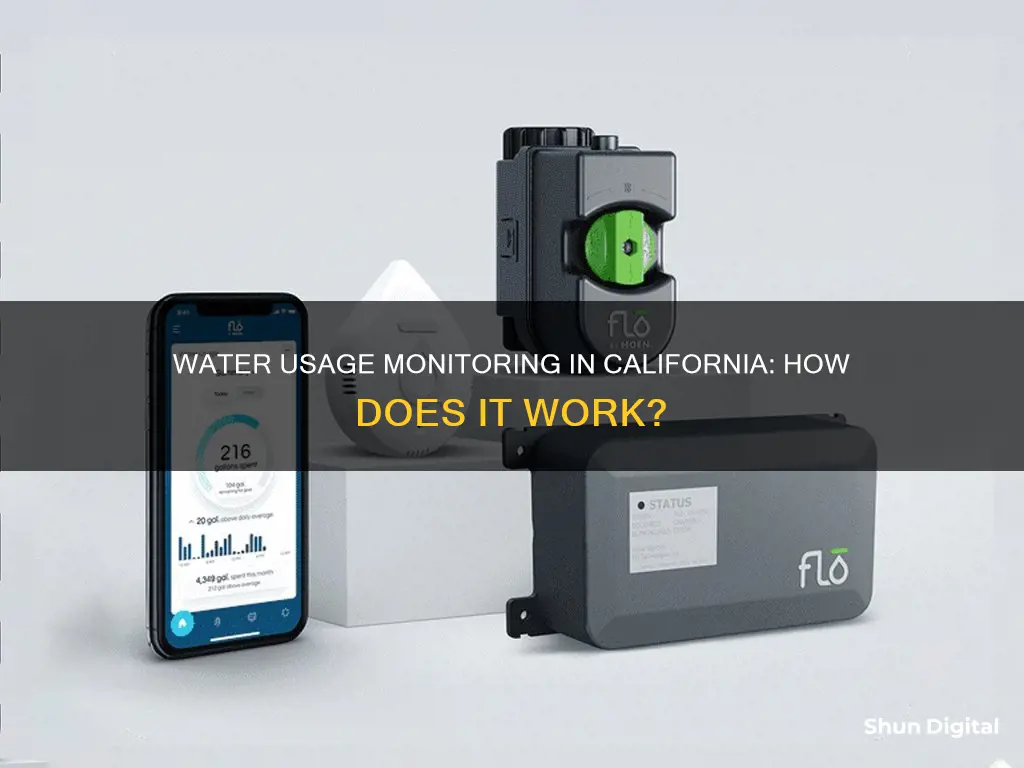
Water usage monitoring is essential for managing water resources efficiently and sustainably, especially in water-scarce regions like California. The state has implemented various methods to track water consumption and distribution, including the use of smart meters, district metering, and remote sensing technologies. California's water usage is divided into three main sectors: communities, agriculture, and the environment, with agriculture accounting for the highest proportion of water usage. The state is also taking steps to improve water infrastructure and promote water conservation among its residents.
| Characteristics | Values |
|---|---|
| How to monitor water usage | Reading the mechanical water meter installed by the water utility company |
| Drawbacks of traditional methods | Inaccuracy associated with manual readings |
| Inefficiency due to labour-intensive and time-consuming processes | |
| Lack of real-time data | |
| Modern solutions | Smart water meters |
| Water flow meters with AI-enhanced monitoring | |
| Smart infrastructure | |
| How water companies monitor water usage | District Metering |
| Advanced Metering Infrastructure (AMI) | |
| Remote Sensing | |
| Ways to save water | SaveWater.CA.Gov |
| California Water Watch |
What You'll Learn

Reading your water meter
Locating your water meter
First, you need to find your water meter. These are usually located in a concrete box near the front curb of your home. The meter box will include a metal or plastic lid that reads "Water" or "Water Meter".
The dial on the meter will rotate when water passes through it. One full rotation of the dial equals 1 cubic foot of water or 7.48 gallons. Water meters measure cubic feet of water used, and to convert this into gallons, you multiply the number of cubic feet by 7.48.
The odometer on the meter works in the same way as the one in your car, recording total water use. The digits from right to left represent 1 cubic foot, 10 cubic feet, 100 cubic feet, and so on.
To determine how much water you use over a period of time, you can take two readings from the odometer, writing them down along with the dates. Subtract the first reading from the second, and this will give you your water use in cubic feet during that period. Multiply this by 7.48 to get your water use in gallons. Finally, divide the water used in gallons by the number of days between readings to get your average gallons per day.
Checking for leaks
To check for leaks, turn off all water indoors and outdoors, including sprinklers and ice makers. If the low flow indicator moves, this may indicate a leak in an appliance or pipe. If the meter shows no obvious movement, make a note of the reading and return in 4 hours to see if there is any change. If you use water during that time, the meter reading will change. If you do notice movement, check all appliances, faucets, toilets, and other water sources for drips or leaks.
Online water usage information
If you have a smart meter, you can also access your water usage information online. Log into the customer portal and select the Water Usage tab, then Usage History to view the monthly billing usage for each month, going back two years.
Monitoring Energy Usage: A Guide to Understanding Your Consumption
You may want to see also

Smart water meters
One of the key advantages of smart water meters is their ability to provide real-time data. Unlike traditional meters that are read manually once a month, smart meters employ wireless signals to deliver hourly, daily, or weekly updates on water use. This enables residents and utilities to track consumption more frequently and accurately. As a result, it becomes easier to identify leaks or irregularities promptly, preventing water wastage and reducing the risk of property damage.
The implementation of smart water meters has broader implications for water management as well. With more precise data, utility companies can better detect leaks in large-scale distribution systems and optimize water flow according to real-time demand. This proactive approach enhances the efficiency and resilience of the water supply system, ensuring a more reliable water distribution network.
While smart water meters offer significant advantages, there are also considerations to be made. The installation of smart meters can be costly, and the technology is continually evolving, requiring ongoing investments to stay up-to-date. Additionally, concerns have been raised regarding privacy and potential health risks associated with radio frequency emissions. However, agencies typically allow customers to opt-out, and the California Council on Science and Technology has concluded that the emissions fall within federal safety standards.
In conclusion, smart water meters are a valuable tool in the effort to conserve water and manage this precious resource more sustainably. By providing real-time data, enhancing consumer awareness, and improving water distribution efficiency, smart water meters play a pivotal role in addressing the challenges posed by California's worsening droughts. As more water agencies adopt this technology, we can expect to see improved water conservation outcomes and a more resilient water management system in the state.
University WiFi: Staff Privacy and Monitoring Concerns
You may want to see also

Water flow meters
In California, water flow meters are particularly important due to the state's commitment to water conservation and the impact of climate change on its water resources. Californians are encouraged to adopt conservation practices to make the most of the state's limited water supplies. Websites like SaveWater.CA.Gov and California Water Watch offer tools to help residents report water waste and stay informed about local and statewide water conditions.
By leveraging water flow meters and embracing smart water monitoring technologies, individuals and communities can play a crucial role in conserving water, promoting sustainability, and ensuring a reliable water supply for the future.
Monitoring KWH Usage: A Simple Guide to Energy Tracking
You may want to see also

District Metering
The process involves closing valves within the distribution pipe network, leaving only a few pipes open to supply and remove water from each DMA. These pipes are fitted with flowmeters to record the flow of water in and out of the area. By comparing the amount of water supplied to the DMA with the total of consumer usage, water companies can identify any discrepancies, known as Non-Revenue Water (NRW). NRW can be caused by a variety of factors, including pipe leaks, fire hydrants, illegal connections, and metering inaccuracies.
One of the key advantages of District Metering is the ability to regulate pressure in each zone. Pressure and leakage are directly related, with higher pressure resulting in increased leakage. By maintaining a constant minimum pressure, companies can reduce leakage while ensuring customer satisfaction. This pressure regulation can be achieved through the use of pressure-reducing valves (PRVs) and booster pumping stations.
Additionally, District Metering improves operational efficiency and asset management. The increased data obtained from zoning allows for data-driven analytics, providing alerts for leakage events and predicting potential pipe failures. This helps to optimise network efficiency and results in significant cost savings for both water companies and consumers.
IBM Employee Internet Usage: Monitored or Not?
You may want to see also

Reporting water waste
Water waste can be reported in California through the SaveWater.CA.Gov website. This online tool allows users to report water waste and suspected leaks in their community. It is simple to use: users select the type of water waste, type in the address, and click send. The report is then directed to the relevant water agency, and the reporter remains anonymous unless they choose to provide their email address for confirmation or further communication.
Many local water agencies in California also have their own methods for reporting water waste, including email, phone, or online apps.
Water waste can also be reported through the Cal Water website, which is committed to supporting customers' water conservation efforts.
The need to monitor and report water waste is becoming increasingly important as the world faces rising water scarcity and communities feel the pinch of water shortages. Water waste reporting is a critical way to help manage our water resources efficiently and sustainably, and new technologies are making it easier to identify and address issues such as leaks or unexpected spikes in usage.
Electricity Usage: Are Police Monitoring Your Power Consumption?
You may want to see also
Frequently asked questions
Companies monitor water usage through the use of water meters, which are typically located near the curb in front of your home under a concrete lid. There are two basic types of meters: the straight-reading meter and the round-reading meter.
To read a straight-reading meter, simply record the figures shown in white and subtract your last reading to determine your usage in hundreds of cubic feet. For a round-reading meter, start with the dial labeled 100,000 and read clockwise to the dial labeled 1,000. If the hand on any dial is between two numbers, use the lower number. Subtract your last reading to determine usage.
It is recommended to read your meter daily or weekly to effectively monitor your usage.
Monitoring water usage is crucial for identifying leaks and managing costs. It also helps conserve water, especially in areas facing water scarcity like California.
Yes, smart water meters are the latest innovation, providing real-time data on water consumption. These high-tech devices transmit detailed usage information directly to the utility provider and the consumer via smartphone apps or web dashboards.







